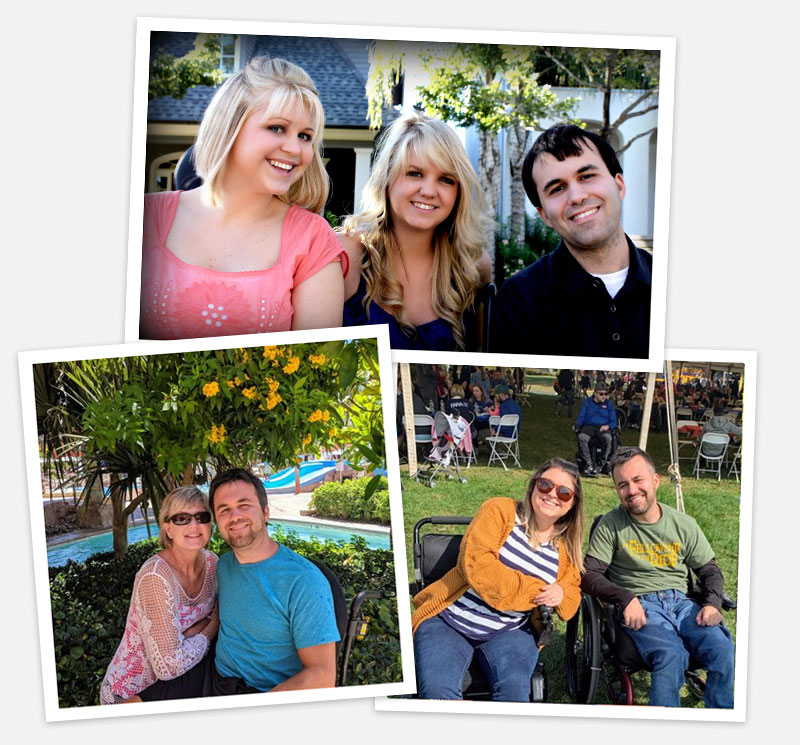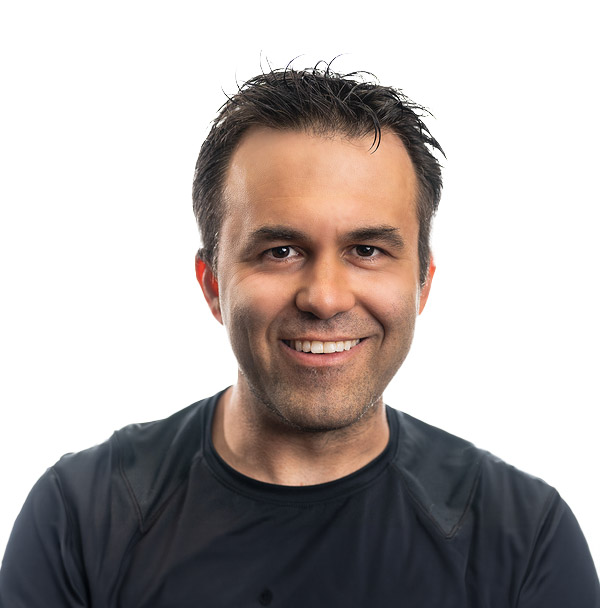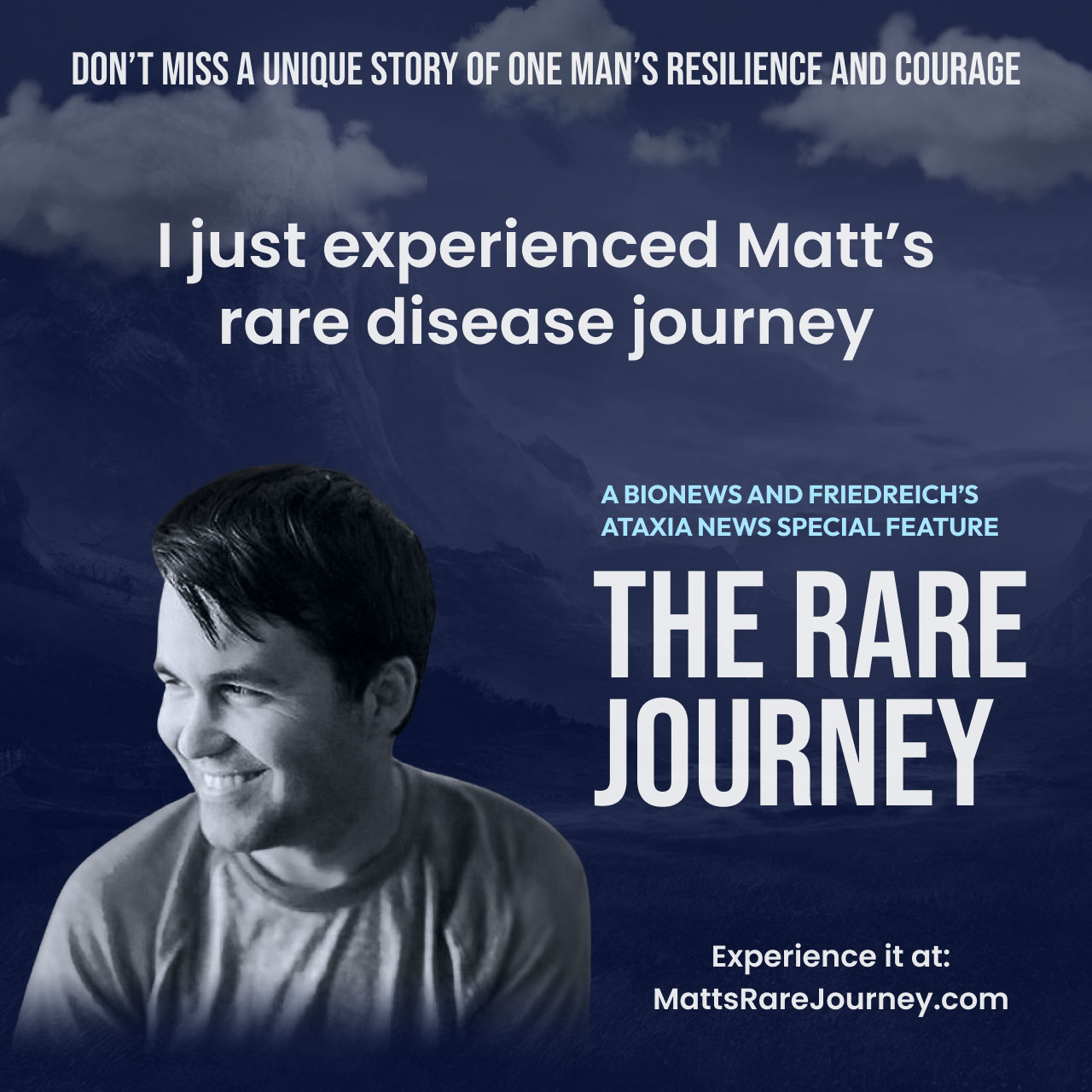



A BIONEWS & FRIEDREICH’S ATAXIA NEWS SPECIAL FEATURE
By Bionews Staff with Matt Lafleur

Diagnosed with Friedreich’s ataxia (FA) at 9 years old, Matt Lafleur’s childhood transformed into a battle against his own decline. He channeled his youthful energy into knowledge, finding his voice as an advocate and ambassador for the FA community. While the fight for a cure persists, Matt isn’t waiting — he’s living, a symbol of hope proving you can thrive, not just survive, with this relentless disease.

Matt’s path from a normal kid to becoming an FA advocate was filled with letdowns, setbacks, and odds that seemed overwhelming. But his hardheaded spirit wouldn’t allow him to give up, and his supportive community taught him how important it is to recognize little victories, especially when your future is uncertain.
MATT’S EARLY YEARS
The year was 1985, and the place was Opelousas, Louisiana. The November air hung heavy with humidity as Matt was born in the heart of Cajun country. Sports were a big deal in his family. His dad, a high school football and baseball star, and his mom, a head cheerleader and all-state softball player, practically lived for games.
Matt, their firstborn, seemed like a natural athlete. He started strong in elementary school soccer, a ball of energy, a pint-sized Messi in mud-caked cleats.
Outside of sports, their lives revolved around barbecues with extended family, Saturday movie nights filled with popcorn, and the thrill of summer trips to the nearest amusement park. It was a typical American childhood of the ’80s, punctuated by cheers at the baseball and soccer fields.
But things changed over time. Matt wasn’t improving as much as the other kids. His feet, once quick and light, became clumsy. The ball wouldn’t do what he wanted it to. His worried parents thought it was just a growth spurt, a temporary, awkward phase.

Matt posing for his Little League photo (circa 1993)
Then came a gymnastics class in third grade. The teacher, a woman with sharp eyes, spoke to Mrs. Lafleur privately. “Maybe it’s his feet,” she said with concern. “Flat feet can mess with a kid’s balance.” Everyone thought a podiatrist visit and some arch supports would fix it.
But the podiatrist, who had seen many patients, saw something more. Matt’s walk wasn’t quite right. It was a small thing, something his parents didn’t notice anymore, just a way he moved.
The doctor’s words were a shock: “Shoe inserts won’t help this. We need a neurologist.” There wouldn’t be a quick fix. This changed everything. A doctor’s visit for flat feet became a scary mystery. Matt’s life, and his family’s lives, were about to take a different direction.
The Louisiana air felt even heavier, filled with unspoken worry. Their perfect athlete, their little Matt, might have a problem much bigger than being clumsy.
STORY CONTINUES BELOW








1993: The LAST YEAR OF NORMAL for MATT AND THE LAFLEUR Family
Watch clips of Matt and his family enjoying life to the fullest. From birthday parties and backyard activities, to playing sports, the Lafleurs were just like every American family in 1993.
The following year would bring news that would alter the course of their lives forever.

THE DIAGNOSIS (AND IT’S NOT JUST MATT)
The doctor visits became a relentless odyssey across Louisiana, spilling over into Mississippi and Texas. Each appointment felt like an inconvenience, a roller coaster of hope and disappointment for his parents.
Doctors examined Matt closely, using confusing medical terms to explain what they found. They all agreed the problem was in the nerves, probably something passed down in the family. This clue, they hoped, might lead to an answer.
Matt’s two younger sisters, who had been on the sidelines before, were now part of the story. One by one, 3-year-old Mckenzie and then 6-year-old Morgan were asked to do a simple test: stand on one leg. Mckenzie, naturally balanced, did it easily. But Morgan, worried and tense, struggled. The news that followed felt like a punch in the gut. Whatever was going on with Matt, Morgan likely had it too.
“The news that followed felt like a punch in the gut. Whatever was going on with Matt, Morgan likely had it too.”
Finding a diagnosis remained frustrating. Each visit felt like a depressing trip with no clear answer. Matt, a kid who loved competition, was stuck in a race he couldn’t seem to win. The search for answers became a routine — sterile waiting rooms and unanswered questions.
A year into their journey, a neurologist in New Orleans, a city known for both its charm and medical expertise, offered a new diagnostic approach. Matt remembers some things — sticky things attached to his legs and Morgan’s, a weird tingling feeling. These, he learned later, were measuring the messages traveling through his nerves, messages that gave the doctor important clues.
The answer, when it finally came, was a long, hard-to-say word: Friedreich’s ataxia.
Matt probably didn’t understand it much at the time. But for his parents, it must have been devastating. Two of their three precious children were facing a mysterious, never-ending illness. Their picture-perfect future had vanished, replaced by a scary unknown.
STORY CONTINUES BELOW
WHAT IS FRIEDREICH’S ATAXIA?
When Matt’s family heard these words uttered by a New Orleans neurologist in 1994, they sounded foreign and confusing.
Friedreich’s ataxia is a rare disease, unfamiliar to most people. To provide clarity, we turned to Giovanni Manfredi, MD, PhD, a world-renowned expert in FA, to offer more information about the condition and how it affects the body. Manfredi is currently professor of neuroscience at Weill Cornell Medical College in New York City.
STORY CONTINUES BELOW
REACTION TO THE DIAGNOSIS
Matt was done with doctor visits. They used to be rare events in his childhood, but now they were constant. All he wanted was a normal life, to go back to school and play sports again.
The truth was harsh. Running, which used to be easy, was now difficult. Balancing, something he never thought about, was a challenge. Even walking in a straight line seemed hard. For a moment, he wondered if it was because of the strange stickers the doctor in New Orleans put on his legs. But that idea didn’t last long. This wasn’t temporary.
Matt always loved sports, so his worsening balance and coordination seemed much more obvious now. He soon quit, which was upsetting. But things kept getting worse. His illness took away his abilities bit by bit. Each new symptom surprised him and left him feeling out of breath and confused.
“It wasn’t about what his body was losing, but what was still there — his spirit and his courage.”
Matt used to be very social; some might even say he talked too much. Now, he didn’t talk to anyone very often. He couldn’t talk to his parents, friends, or even his sister, Morgan, who was going through this with him.
He couldn’t find the words, and his feelings were all mixed up. Middle school was a blur of quiet hallways and a growing sense of despair.
But even in the darkness, Matt found a little bit of hope. He was raised Catholic, and his childhood beliefs comforted him. His faith helped him during this difficult time. A specific Bible verse was a light in the darkness: “Don’t be impressed by his appearance. … God looks at the heart” (1 Samuel 16:7).
It wasn’t about what his body was losing, but what was still there — his spirit and his courage. This small spark of hope would be what helped Matt get through the tough times ahead.
STORY CONTINUES BELOW
WATCH MATT’S FATHER TALK ABOUT THE DAY OF THE DIAGNOSIS
In this emotional video, Freddie Lafleur, father of Matt and Morgan, describes the day their family received the life-altering diagnosis of Friedreich’s ataxia.
FACING THE MONSTER
Matt couldn’t ignore the name “Friedreich’s ataxia” anymore. In his first year of high school, his balance and walking kept getting worse. He couldn’t pretend it wasn’t happening anymore. He went online to learn everything he could about this disease.
He decided to put his clunky home computer to work, and he first typed in “Friedreich’s ataxia” around 1999.
Even though Matt had been diagnosed years before, he never really took ownership of his diagnosis. He didn’t want to live in fear of the unknown anymore. He held his breath and clicked “search.”
What he found was both good and bad news. He felt relieved to finally have a medical explanation for his clumsiness. It wasn’t his fault. These were the symptoms he’d been experiencing, and it explained why he’d felt unwell for years. But the more he read, the more scared he became.
“It didn’t matter that his body was failing him, his spirit was still strong.”
The disease wouldn’t get better. It would spread to his arms, voice, and even his heart. He wouldn’t live a long life. Playing sports, something he still secretly hoped for, was definitely out of the question. Wheelchairs, not sports cleats, were what people with FA ended up using.
Then came the worst part: There was no cure. There wasn’t a medicine or surgery to fix the damage. The disease would just keep getting worse. It felt unfair. He wanted to fix it, but there was nothing he could do. He felt hopeless.
He couldn’t talk to anyone about it. He withdrew even more, preferring to be alone. Loud music helped him block things out. He listened to songs about hope and teenage angst. Video games provided a temporary escape from reality.
Since Matt didn’t talk about his diagnosis, he turned to writing bad teenage poetry to express his confusion, sadness, angst, and other bottled-up emotions.
It didn’t matter that his body was failing him; his spirit was still strong.
High school was a challenge. Matt wanted to be independent, so he used the lockers to hold himself up as he walked through the hallways. Using his surroundings to get around, he felt almost normal.
But things were getting harder. By senior year, stairs were impossible, and he couldn’t walk without help anymore.
STORY CONTINUES BELOW









TEST YOUR KNOWLEDGE
See how much you know about Friedreich’s ataxia.
Matt reignited his passion for physical activity and, as a result, goes to physical therapy at an adaptive gym twice a week. As part of Friedreich’s ataxia treatment, physical therapy may prolong motor function capacity (including the ability to walk) and help achieve a higher quality of life for as long as possible.
Matt reignited his passion for physical activity and, as a result, goes to physical therapy at an adaptive gym twice a week. As part of Friedreich’s ataxia treatment, physical therapy may prolong motor function capacity (including the ability to walk) and help achieve a higher quality of life for as long as possible.
FINDING THE MISSING PIECE
Following his graduation, Matt’s job search for a counseling position proved difficult. Despite efforts in Baton Rouge, he found no opportunities and returned to Opelousas with hopes of finding a job close to home. Rejection continued. He relocated to Lafayette, moving in with a friend while continuing his search.
After three years and numerous interviews, he eventually moved back home in 2013, feeling defeated and ready to surrender. He believed his worsening disability and FA were the reason he wasn’t hired. He felt victimized by his condition.
His counseling dreams were on hold. And he opted to help his family with their Cajun food business.
He moved back in with his mom. She updated an old house on their property so he could use his wheelchair easily. But FA kept taking away his independence. It was getting harder and harder for him to do things on his own. He hired someone to help him around the house, and his mom was also there for him.

(Clockwise) Matt with sisters Morgan (l) and Mckenzie (r) (circa 2012). Matt and his mom in Turks and Caicos in 2018. Matt and Morgan at rideATAXIA 2022.
Around 2017, Matt realized something. He was comfortable, but his life didn’t feel real. How could he help others with FA if his only connection to the FA community was his sister?
That year, he looked online and found out about a bike ride for FA happening in Dallas, Texas. He contacted the person in charge, Kyle Bryant.
Matt learned that Kyle worked for a nonprofit called FARA, which stands for Friedreich’s Ataxia Research Alliance. FARA raises money for FA research with the goal of slowing, stopping, reversing, and eventually curing the disease. RideATAXIA is one of their biggest fundraisers, with bike rides held in several U.S. cities each year. Kyle himself had FA and started the rides.
Matt connected with Kyle’s story. Here was someone with FA who was successful, an advocate for the disease who still loved adventure. They started emailing in 2017 and became good friends. Kyle introduced Matt to other people with FA and got him interested in riding a special kind of tricycle.
FA used to make Matt feel isolated, but now it connected him to a community. He didn’t feel alone anymore.
Inspired by Kyle’s contagious passion and creativity, Matt volunteered part time for FARA as a patient ambassador. Matt’s passion for counseling and mental health was finally being put to use mentoring new FA patients and their families.
Driven by his volunteer work with FARA, Matt applied for a contractor position as a columnist with Bionews for its website Friedreich’s Ataxia News. He hoped to use his writing and counseling skills to help and inspire the FA community. Matt began his new role in 2018 and never looked back.
Through his column “Little Victories,” Matt strives to advocate for not only FA but also the other 50-plus rare and chronic conditions covered by Bionews. He eventually joined Bionews full time in 2019 and now serves as the director of business development and patient advocacy.
STORY CONTINUES BELOW
One of the activities Matt loves to do is ride his trike with his retired service dog, Zeego, in the lot behind his family’s business.
One of the activities Matt loves to do is ride his trike with his retired service dog, Zeego, in the lot behind his family’s business.
A NEW HOPE: TREATING THE UNTREATABLE
February 28, 2023: a date etched in Matt’s memory, the day his world shifted. The FDA approved Skyclarys (omaveloxolone), the first targeted treatment for Friedreich’s ataxia. A disease once deemed “untreatable” now had a glimmer of hope on the horizon.
Sure, Skyclarys wasn’t a cure. It was only approved for U.S. patients over the age of 16. But for Matt and countless others living with FA, this was a game-changer. He began taking it daily, a tangible symbol of the progress made.
This wasn’t just a personal victory for Matt. It marked a new chapter in the FA community’s relentless fight. The fight for wider access to Skyclarys, the fight for a true cure — these battles burned brighter now, fueled by a newfound optimism. Hope, a precious commodity, had been rekindled.
Matt, the once isolated teenager grappling with his diagnosis, now stood tall as a promise of hope for others. His journey, a testament to resilience and the power of community, continues to inspire. The future, once uncertain, now held the promise of a better tomorrow, not just for Matt, but for everyone battling FA. To learn more about Skyclarys and emerging experimental treatments, visit the Friedreich’s Ataxia News treatment page.
LEAVE SOME LOVE, AND A NOTE, FOR MATT
This is an opportunity for you to share any words or thoughts with Matt and for all to see. Please note: Comments will be held for moderation and we will email you once it is posted to the page. Please input your name as you would like it to be publicly displayed on the note.
SHARE YOUR ♥ FOR MATT AND
THIS IMMERSIVE EXPERIENCE ON YOUR FEED.
Check out Matt’s column “Little Victories” on Friedreich’s Ataxia News to follow him on his journey.
SHARE YOUR ♥ FOR MATT AND
THIS IMMERSIVE EXPERIENCE ON YOUR FEED.
Check out Matt’s column “Little Victories” on Friedreich’s Ataxia News to follow him on his journey.
BEFORE YOU GO…LET US KNOW YOUR THOUGHTS
We want to hear from you! Please take a moment to share your experience with our immersive storytelling program. Your feedback will help us enhance future programs and connect with more patients.
ADDITIONAL RESOURCES
Check out our other resources on Friedreich’s Ataxia News to help you navigate your FA journey.
This site is strictly a news and information website about the disease. It does not provide medical advice, diagnosis or treatment. This content is not intended to be a substitute for professional medical advice, diagnosis, or treatment. Always seek the advice of your physician or other qualified health provider with any questions you may have regarding a medical condition. Never disregard professional medical advice or delay in seeking it because of something you have read on this website.













